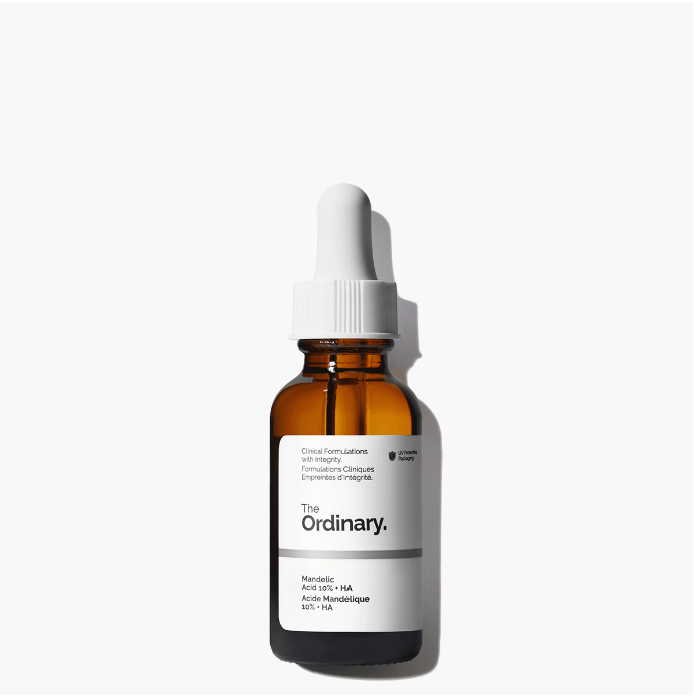
Mandelic acid is an alpha hydroxy acid (AHA) derived from bitter almonds and is known for its effective exfoliation capabilities that are gentle on the skin.
Its unique molecular structure is larger than other AHAs, allowing for a slower, more controlled penetration into the skin, reducing the potential for irritation. This makes mandelic acid particularly suitable for those with sensitive skin.
When incorporated into a skincare regimen, mandelic acid can offer a multitude of benefits. It can stimulate collagen production, aiding in skin repair and rejuvenation.
Additionally, it is effective in addressing acne, improving skin texture, diminishing hyperpigmentation, and reducing the visibility of fine lines and wrinkles.
Mandelic acid functions by loosening the bonds between dead skin cells, enabling their easy removal and, thus, unveiling the newer, brighter skin beneath. Beyond mere exfoliation, it also possesses antibacterial properties that can be advantageous for acne management.
In the realm of AHAs, mandelic acid is often contrasted with glycolic acid. While both serve to exfoliate the skin, mandelic acid is typically considered the gentler option, often resulting in less irritation for the user.
Properties and Composition
Mandelic acid stands out due to its chemical composition and properties, which influence its effectiveness and application in skin care.
So, how does this acid stack up against its AHA cousins? Let’s take a closer look.
Molecule Size and Skin Penetration
The molecule size of mandelic acid is roughly double that of glycolic acid, one of the smallest AHA molecules. This means that while glycolic acid can penetrate the skin deeply and quickly, mandelic acid takes a gentler approach, making it an excellent choice for even sensitive skin types.
Comparison with Other AHAs
Mandelic acid is part of the alpha hydroxy acids family, which includes well-known members like glycolic acid and lactic acid.
Glycolic and lactic acid offer different advantages. Glycolic, the smallest and punchiest, delivers intense exfoliation for brightening and anti-ageing. Lactic, which balances gentleness and effectiveness, is often chosen for its hydrating properties and compatibility with sensitive skin.
Mandelic acid stands out among AHAs with its gentle touch and cleansing power. Its larger size means it glides slowly through the skin, minimising irritation. This makes it a dream for sensitive skin and hyperpigmentation, where harshness is unwelcome. Plus, its oil-loving nature lets it dive into clogged pores, tackling acne and blackheads head-on.
6 Skin Benefits of Mandelic Acid
While all AHAs exfoliate and brighten the skin, mandelic acid has some specific strengths. It specifically targets issues such as acne, ageing, and uneven skin tone, working effectively across various skin types.
- Accelerates Cell Turnover
Mandelic acid is an exfoliant that accelerates cell turnover, which helps shed dead skin cells and reveal newer, healthier layers underneath. Regular use can lead to smoother skin and a more refined skin texture.
- Helps With Acne and Sebum Control
If you have acne-prone skin, mandelic acid helps manage breakouts by regulating sebum production and helping unclog pores. Its antibacterial properties are effective in reducing acne without causing significant irritation.
- Has Anti-ageing Effects
This gentle alpha hydroxy acid supports collagen production, which improves skin elasticity and reduces the appearance of fine lines and wrinkles. It offers the skin a firmer, more youthful look over time.
- Helps Fade Hyperpigmentation and Dark Spots
Regular application of mandelic acid can help to fade dark spots and address hyperpigmentation issues, such as melasma. Its ability to break up pigmentation makes it a valuable addition to a targeted skincare regimen.
- Improves Skin Texture and Complexion
Mandelic acid contributes to a smoother and brighter complexion by promoting exfoliation and collagen synthesis. It improves the overall skin texture, making it appear more luminous.
- Reduces Inflammation and Irritation
Mandelic acid has anti-inflammatory properties, making it appropriate for those with sensitive skin. It can alleviate redness, swelling, and itching, contributing to a calmer, more balanced skin condition.
Mandelic Acid and Different Skin Types

Mandelic acid offers a range of benefits tailored to various skin types. Its molecular structure lets it penetrate the skin slowly, reducing potential irritation whilst effectively targeting skin concerns.
Sensitive Skin Suitability
For those of you with sensitive skin, mandelic acid is a boon due to its large molecular size, which allows for a slower, gentler absorption, minimising the likelihood of irritating the skin. This property makes it preferable for addressing issues like rosacea and uneven skin tone without the harshness encountered in other AHAs.
Dry and Oily Skin Types
Your skin type plays a vital role in how you should apply mandelic acid. If you have dry skin, pair it with ample hydration to avoid exacerbating dryness. For oily skin types, mandelic acid can help manage oil levels, but be cautious not to overuse it, as this can lead to the over-production of oil as a response to excessive exfoliation.
Uneven Skin
Mandelic acid demonstrates versatility and is able to address dullness and refresh uneven skin, making it suitable for a variety of conditions. Its oil-soluble nature means it can also effectively manage oily skin by penetrating the pores and helping to regulate sebum production.
When and How to Apply Mandelic Acid
To fully benefit from mandelic acid’s exfoliating and antibacterial properties, you should follow the best practices for application and frequency.
Below, we’ll go through some helpful tips on how to use this AHA, integrate it with other treatments, and protect your skin from potential sun sensitivity.
Recommended Routines and Frequency
To begin with, mandelic acid can be found in various forms, such as peels, serums, and cleansers. For optimal results, start by applying a product with mandelic acid two to three times per week in the evening. Gradually increase frequency as your skin builds tolerance. Ensure you:
- Cleanse your skin thoroughly.
- Apply mandelic acid on dry skin to avoid irritation.
- Wait until the acid is fully absorbed before proceeding.
In the market for mandelic acid? Try this crowd favourite: The Ordinary’s Mandelic Acid 10% + HA.
Others like it because:
- It’s Hydrating: Contains hyaluronic acid which hydrates the skin, enhancing the exfoliation process without drying it out.
- It’s Suitable for Sensitive Skin: The formulation is designed to be gentle enough for all skin types, including those with sensitive skin.
- It Improves Skin Texture: Regular use helps to smooth out textural irregularities for a more refined skin appearance.
- It Evens Skin Tone: The exfoliating action can help to reduce the appearance of uneven skin tone and dark spots.

Layering with Other Treatments
Mandelic acid can be layered with other skin care products but should be done so with caution to avoid over-exfoliation or interactions:
- Do not use with other strong actives, like glycolic acid, salicylic acid (BHAs), or retinol, on the same night.
- Hyaluronic acid and niacinamide are safe to use for added hydration and to minimise irritation.
- If using a mandelic acid peel, wait at least a week before using other potent exfoliants.
Importance of Sunscreen in Conjunction with AHAs
While AHAs like mandelic acid can improve your skin’s appearance, they also increase photosensitivity, making sunscreen indispensable in your regimen.
Always:
- Apply a broad-spectrum SPF 30 or higher every morning.
- Reapply sunscreen every two hours when exposed to direct sun exposure.
- Consider wearing protective clothing and seeking shade during peak hours.
Potential Side Effects
To minimise adverse effects, apply a small amount on a discreet skin area 24 hours prior to full application. This can help identify any sensitivity or possible skin irritation. Always follow the product’s instructions and use sunscreen daily, as AHAs can make your skin more sensitive to the sun.
Common Reactions and Skin Sensitivities
Despite its gentleness compared to other AHAs, mandelic acid can still unexpectedly cause skin irritation. This usually manifests as temporary redness, tightening, and mild itching, which may be more prominent for individuals with sensitive skin.
Long-Term Effects and Dermatologist Guidance
Prolonged use of mandelic acid can lead to over-exfoliation, causing discolouration and increased vulnerability to UV radiation. For persistent issues such as acne scars, blackheads, and significant discolouration, consult with a dermatologist.
Remember, your skin is unique! While mandelic acid is generally considered safe, It’s always best to consult a dermatologist or skincare professional for personalised advice.
Takeaway
Mandelic acid, a gentle alpha hydroxy acid from bitter almonds, is distinguished by its large molecular structure, allowing slower absorption and minimising skin irritation.
Ideal for sensitive skin, it exfoliates, promotes collagen production, and has antibacterial properties that help with acne management. Mandelic acid also targets hyperpigmentation and ageing, improving skin texture and reducing fine lines for a youthful appearance.
Unlike other AHAs, mandelic acid is less likely to irritate, making it suitable for various skin types. It should be introduced into skincare routines gradually, with sunscreen as an essential daily accompaniment due to increased photosensitivity.
While generally safe, consulting with a dermatologist is advised for personalised use and to mitigate potential long-term effects.